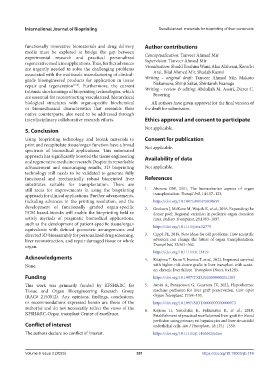Page 359 - IJB-9-3
P. 359
International Journal of Bioprinting Decellularized materials for bioprinting of liver constructs
functionally innovative biomaterials and drug delivery Author contributions
media must be explored to bridge the gap between Conceptualization: Tanveer Ahmad Mir
experimental research and practical personalized Supervision: Tanveer Ahmad Mir
regenerative medicine applications. Thus, further advances Visualization: Shadil Ibrahim Wani, Alaa Alzhrani, Kenichi
are urgently needed to solve the challenging problems Arai, Bilal Ahmed Mir, Shadab Kazmi
associated with the multiscale manufacturing of clinical- Writing – original draft: Tanveer Ahmad Mir, Makoto
grade bioengineered products for application in tissue Nakamura, Shinji Sakai, Shintaroh Iwanaga
repair and regeneration [150] . Furthermore, the current Writing – review & editing: Abdullah M. Assiri, Dieter C.
intrinsic shortcomings of bioprinting technologies, which Broering
are essential for reconstructing vascularized, hierarchical
biological structures with organ-specific biochemical All authors have given approval for the final version of
or biomechanical characteristics that resemble their the draft for submission.
native counterparts, also need to be addressed through
interdisciplinary collaborative research efforts. Ethics approval and consent to participate
5. Conclusion Not applicable.
Using bioprinting technology and bioink materials to Consent for publication
print and recapitulate tissue/organ function have a broad Not applicable.
spectrum of biomedical applications. This automated
approach has significantly boosted the tissue engineering Availability of data
and regenerative medicine research. Despite its remarkable
advancement and encouraging results, 3D bioprinting Not applicable.
technology still needs to be validated to generate fully
functional and mechanically robust bioprinted liver References
substitutes suitable for transplantation. There are
still areas for improvements in using the bioprinting 1. Abouna GM, 2001, The humanitarian aspects of organ
approach for clinical applications. Further advancements, transplantation. Transpl Intl, 14:117–123.
including advances in the printing resolution, and the https://doi.org/10.1007/s001470050859
development of functionally graded organ-specific 2. Godown J, McKane M, Wujcik K, et al., 2016, Expanding the
ECM based-bioinks will enable the bioprinting field to donor pool: Regional variation in pediatric organ donation
satisfy myriads of pragmatic biomedical applications, rates. Pediatr Transplant, 20:1093–1097.
such as the development of patient-specific tissue/organ https://doi.org/10.1111/petr.12779
equivalents with defined geometric arrangements and
directed 3D bioassembly for personalized drug screening, 3. Cippà PE, 2019, New ideas for old problems: How scientific
liver reconstruction, and repair damaged tissue or whole advances can change the future of organ transplantation.
organ. Transpl Intl, 32:561–562.
https://doi.org/10.1111/tri.13419
Acknowledgments 4. Kitajima T, Kuno Y, Ivanics T, et al., 2022, Improved survival
None. with higher-risk donor grafts in liver transplant with acute-
on-chronic liver failure. Transplant Direct, 8:e1283.
Funding https://doi.org/10.1097/TXD.0000000000001283
This work was primarily funded by KFSH&RC for 5. Amin A, Panayotova G, Guarrera JV, 2022, Hypothermic
Tissue and Organ Bioengineering Research Group machine perfusion for liver graft preservation. Curr Opin
(RAC# 2150012). Any opinions, findings, conclusions, Organ Transplant, 27:98–105.
or recommendations expressed herein are those of the https://doi.org/10.1097/MOT.0000000000000973
author(s) and do not necessarily reflect the views of the 6. Kojima H, Yasuchika K, Fukumitsu K, et al., 2018,
KFSH&RC-Organ transplant Centre of excellence. Establishment of practical recellularized liver graft for blood
perfusion using primary rat hepatocytes and liver sinusoidal
Conflict of interest endothelial cells. Am J Transplant, 18:1351–1359.
The authors declare no conflict of interest. https://doi.org/10.1111/ajt.14666Citation
Volume 9 Issue 3 (2023) 351 https://doi.org/10.18063/ijb.714

